
Insights
October 23, 2024
A Change in Sentiment
In Investments, Market Commentary

Fears of recession in August, sparked by a worse-than-expected July jobs report and an uptick in unemployment, resulted in the S&P 500 Index declining by 8%. Many market participants expressed concern that the Federal Reserve (the Fed) waited too long to cut the Fed Funds rate.
In September, the Fed responded to the potential cracks in the economy, especially in the labor market, by lowering the Fed Funds rate by 50 basis points and indicating that more rate cuts would follow. Bearish sentiment gave way to economic optimism as the August jobs report was stronger than expected, inflation continued to recede, and corporate earnings for the second quarter were strong ― up over 13%. Sparked by this strong economic data and lower interest rates, the U.S. equity markets staged a strong rally in September with the S&P 500 Index ending the quarter at an all-time high.
Market Leadership
With lower interest rates and contained inflation, market leadership changed. The small cap stock index, the Russell 2000, lagged the large cap indices coming into the quarter, but was the best performing domestic index for the quarter, gaining 9.27%. Lower interest rates and contained inflation disproportionately help these small cap companies, as 41% of the stocks that compose the Russell 2000 Index are not profitable and rely on floating rate debt to continue operations. Cheaper debt enhances those companies’ prospects for survival.
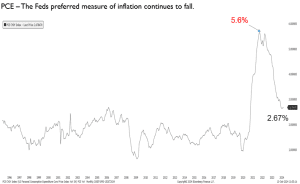
Source: Bloomberg
Within large cap stocks, there was significant sector rotation as well. The seven mega-cap tech stocks known as the Magnificent Seven, which significantly outperformed the S&P 500 Index last year and in the first half of this year, significantly underperformed the Index in the third quarter. The Magnificent Seven returned 5.43% for the quarter while the S&P 500 Index minus the Magnificent Seven returned 8.02%.
MAG 7 VS. THE S&P 500 MINUS THE MAG 7
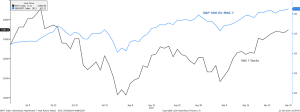
Source: Bloomberg
Simultaneously, utilities, financials and other dividend paying stocks, which had underperformed the S&P 500 prior to the 3rd quarter, outperformed the market as the steady cash flows that dividends provide became more appealing with declining inflation and interest rates.
Potential Cracks?
The U.S. equity markets are pricing in the optimistic view that the trend of continued growth and subsiding inflation will continue, and the economy will experience a “soft landing.”
This optimistic view apparently ignores the economic bifurcation occurring in the U.S. with middle- and upper-income households faring well with strong debt-to-income ratios, while other households appear to be struggling as credit card and auto loan delinquencies are rising.
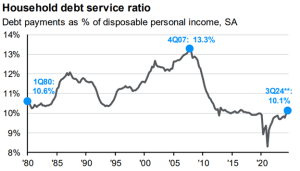
Source: JP Morgan
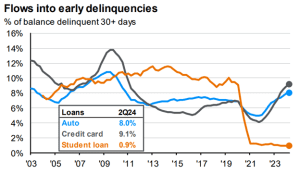
Source: JP Morgan
With equity valuations stretched, we continue to keep a close watch on corporate profitability. If corporations can meet or exceed earnings expectations, the rally could well continue; however, if earnings projections do not meet expectations, a sell-off could well occur.
Global Markets Rally
The rally in equity markets was not confined to the U.S. Equity markets in Europe also rallied. With the exception of Japan, developed markets’ Central Banks are also cutting interest rates as inflation globally has receded.
The strongest equity market rally was in China’s equity as the government announced economic stimulus measures to support the country’s property market, causing the MSCI China Index to gain over 16% for the quarter and rallying over 21% in six days after the government announced those stimulus measures. Prior to the announced stimulus, Chinese equities were one of the worst performing equity asset classes globally.
MSCI CHINA STOCK INDEX

Source: Bloomberg
Interestingly, this global bullishness is occurring despite the volatile geopolitical landscape of two world wars and a hotly contested U.S. election.
Whether optimistic or pessimistic about the near-term movements of the financial markets, we continue to strongly believe in maintaining a diversified portfolio. No asset class outperforms all others for extended periods of time and maintaining a diversified portfolio of stocks and bonds allows you to participate in the upside in market rallies but protects you when the equity markets sell off.
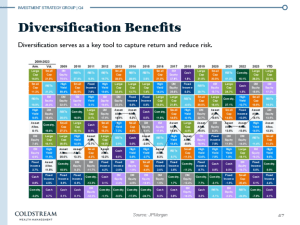
Source: JP Morgan
Thank you once again for your trust in us. If you have any questions or comments, please feel free to contact your Wealth Manager, your Portfolio Manager, or me.
Insights Tags
Related Articles

June 24, 2025
Managing Increased Uncertainty in the Middle East




June 4, 2025
Watch Coldstream’s Q2 2025 ISG Webinar





May 12, 2025
Why people make irrational financial decisions

